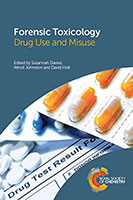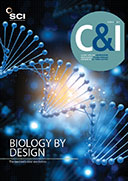Drug busters
Reviewer
John Mann

There is a seemingly insatiable appetite for TV dramas about forensic science. While most of these involve an element of toxicology to determine cause of death, they give a false impression of the most important work carried out in contemporary forensic science labs. Much of the routine work and research is focused on analysis of drug use and misuse, and four main areas can be identified: novel psychoactive substances (NPS); drugs in the sport; sub-standard generic drugs and vaccines; and contamination of water by drugs.
For example, while the long-term eco-toxicological effects of contraceptive steroids in river water have been studied for some time, the effects of rising levels of metabolites of popular drugs like ibuprofen, amoxicillin, acetaminophen and even sildenafil (Viagra) are only now being examined. Studies like these have revealed how the levels of drug metabolites in water sources can vary widely. Thus in Spain river water concentrations of cocaine, cannabis and methadone average 2.1ngL-1, but the value in Barcelona is 7.4ngL-1 and in Toledo is a more modest 0.99ngL-1.
Probably the biggest expansion of interest in forensic toxicology has followed the emergence of the so-called legal highs, like mephedrone. This structural analogue of cathinone (from khat) first appeared in Europe around 2007 and rapidly rose to become the most used drug in clubs and schools. Indeed much of the supposed ecstasy (MDMA) that is seized is now largely composed of mephedrone and its analogues. The UK government’s latest Psychoactive Substances Act, which came out in May 2016, was designed to control the sale of easily synthesised designer drugs that are analogues of MDMA, cathinone, cannabinoids and other small molecule neuroactive substances.
The success of the Act will depend upon the detection and accurate analysis of these substances, together with methods that demonstrate their psychoactivity. The strength of legal cases may ultimately depend upon a clear definition of psychoactivity.
The recent Olympic Games in Rio led to a renewed interest in drugs in sport and to the ever more subtle use of hard-to-detect agents. While use of steroids and bronchodilators is now easily detected, the glycoprotein hormone erythropoietin (EPO), the main regulator of red blood cell production, is hard to detect. Its short biological half-life means that it rapidly disappears from tissues and allows athletes to taper off its use as a sporting event approaches. More controversial is the use of xenon to boost EPO production, and the World Anti-Doping Agency (WADA) is still assessing its ability to detect the gas.
In addition, there is considerable emerging evidence of fake vaccines and sub-standard generic medicines on the market. A large proportion of the latter is now produced legitimately in Eastern Europe, China and India, but the level of quality control is not always up to UK standards. There is also a growing level of criminal activity.
These four areas of drug use and misuse provide ample evidence for the timeliness of a book on forensic toxicology, and this one provides comprehensive coverage of these and many other topics. Cannabis and synthetic cannabinoids receive special attention, owing to the surge in interest in these psychoactive substances. There are 2.3m regular users of cannabis in the UK but it is difficult to predict the dose of THC (tetrahydrocannabinol) produced by the numerous strains of the plant. For example, home-produced Dutch cannabis contains 20% THC while imported strains from North Africa contain as little as 7% THC. In addition, there are now dozens of synthetic cannabinoids, most modelled on N-pentyl-3-(1’-naphthoyl) indole. These analogues are usually sold as Spice and detection and identification of these new analogues provides a continuing challenge for the forensic toxicologist.
The New Zealand government has attempted to tackle these challenges by banning NPS awaiting identification or classification. Interestingly, New Zealand does not have a major problem with cocaine or amphetamines due in part to its isolation, but synthetic cannabinoids and cathinones are locally produced. Unsurprisingly, Kava (a plant extract) is the fifth most popular drug since it is widely used in the Pacific islands.
Our own new Psychoactive Substances Act receives extensive coverage and there is an interesting comparison of the UK classification of drugs (Misuse of Drugs Act 1971) with its US counterpart. The latter has five schedules rather than four categories, with cannabis in schedule I rather than category B, and cocaine in schedule II rather than in category A. The Federal Analog Act has protected the US from the plethora of designer drugs that have plagued Europe over the past 10–15 years.
Several chapters are devoted to the latest techniques of analysis, including nail testing in post-mortem samples; hair analysis for cannabinoids; and sweat and saliva testing for recent drug use. The emerging use of so-called ‘smart drugs’, which provide neuroenhancement and are estimated to be used by 25% of US students to improve academic performance, is an emerging area of significant interest.
The book concludes with a rather quirky chapter of case studies involving deaths due to poisoning with alcohol, carbon monoxide, cyanide, cocaine, date rape drugs and plant toxins. The author offers sound advice for anyone tempted to become an expert witness: ‘Don’t make a speech, don’t interrupt the judge, don’t cross-examine counsel, don’t make any jokes and don’t say anything in Latin.’
The book is readable, timely and comprehensive, and should at the very least be purchased by all forensic science labs.
John Mann is emeritus professor of chemistry at Queen’s University Belfast, UK.
The best way to keep up to date with all of the latest, cutting edge technologies from the lab to the market!
Author
Publisher
Pages
Price
ISBN





